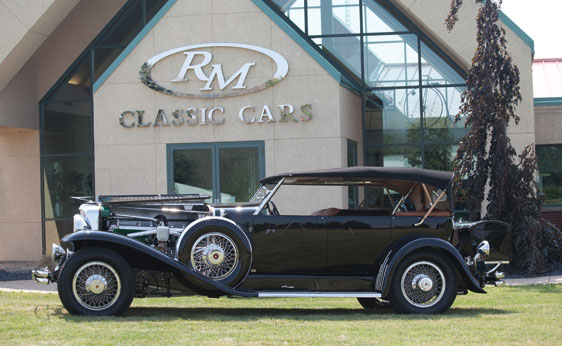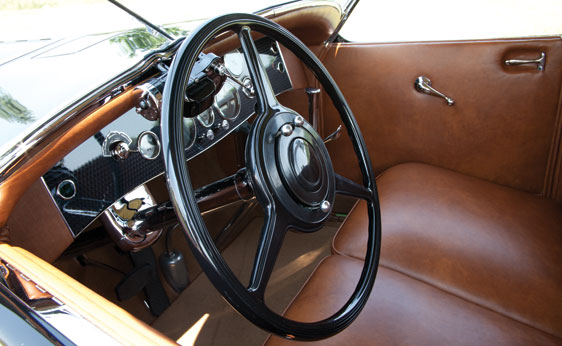1929 Duesenberg Model J Dual Cowl Phaeton
Coachwork by The Walter M. Murphy Company
Chassis no. 2196
Engine no. J175
Marque History
The Model J Duesenberg has long been regarded as the most outstanding achievement of Classic Era design and engineering. When introduced in 1929, trading was halted on the New York Stock Exchange for the announcement. At $8,500 for the chassis alone, it was by far the most expensive car in America. With coachwork, the delivered price of many Duesenbergs approached $20,000, a staggering sum at a time when a typical new family car only cost around $500.
Few would argue that the car’s features did not support its price. Indeed, the Model J’s specifications sound current today: double overhead camshafts, four valves per cylinder, power hydraulic brakes, and 265 bhp in naturally aspirated form or 325 bhp when supercharged.
The new Duesenberg was tailor-made for the custom body industry. It had the power and stance to carry the most imposing coachwork, and the style and grace of the factory sheet metal was ideally suited for the execution of elegant custom bodywork. The Murphy body company of Pasadena, California is generally recognized today as the most successful coachbuilder on the Duesenberg Model J chassis. Associated initially with Packard, Murphy-built bodies were remarkably simple yet elegant, with trim lines and an undeniable sporting character. Murphy designs seemed even more revolutionary when compared to those from their East Coast contemporaries, which built heavier and more ornate designs.
A trademark of Murphy body design was the “clear vision” windshield pillar, designed to be as slim as possible and creating a sportier and more open appearance while improving visibility for the driver. In fact, Murphy advertised that their windshield pillars were “narrower than the space between a man’s eyes,” a design they claimed eliminated blind spots.
Model J Dual Cowl Phaeton, J175
Murphy built only three Duesenberg Model Js with the very sporting Dual Cowl Phaeton body design. Since this particular car, J175, served as the prototype for the Murphy design, it was also the first example of the series built. Another Murphy Dual Cowl body was originally mounted on J336, but it was later paired with the chassis of J403. The other Murphy Dual-Cowl body is with J347.
Design features include incredibly clean bodylines that are completely free of external door handles or any other items, such as moldings or pinstripes, to mar the clean and very long sides of the car. The rear split-V windshield design is unique with its steep rake, and it is mounted to a remarkably long rear cowl. The rear cowl, like the windshield, is split in the center, with each half of the cowl supported by a strong tubular framework underneath. Each half of the cowl can be pivoted upward independently of the other, providing ease of entry and exit for rear-seat passengers. The stylistic effect of the V-shaped rear windscreen and long rear cowl is clearly reminiscent of an aircraft or speedboat cockpit of the era.
In addition to the unmistakable Duesenberg radiator grille and commanding proportions, J175 features a real 1930s-era sportsman’s color combination with a black body, a saddle leather interior and a black folding top. Other great period accents include dual Trippe safety lights, dual chrome-plated horns, Twilite headlamps and dual cowl lights, dual side-mounted spares with body-color hard covers and chrome-plated tread covers, a polished solid cast-aluminum luggage rack, dual brake lamps and a standard Duesenberg exhaust bypass.
In addition to the car’s trademark “clear vision” windshield pillars by Murphy, another remarkable design feature is marked by the car’s front side windows, which mainly provide protection from the wind at speed. As they are raised and lowered, a cleverly designed flap opens and closes over the exposed window pocket, marking yet another amazing example of the close attention to detail inherent in Murphy’s body designs.
All of these distinctive Murphy design features, enhanced by the car’s color combination, represent what is probably the best combination of design, styling and sporting appearance on the powerful Duesenberg Model J chassis.
Unlike many other examples, this Model J remains a remarkably original car in its specifications today. Not only does it retain the original Murphy body but also the original engine that has been overhauled perhaps just two or three times during its lifetime, as well as the original chassis, numbered 2196, and the cast-aluminum firewall, also numbered 2196.
Provenance
On August 10, 1929, J175 was sold new to the larger-than-life S.L. “Roxy” Rothafel of Roxy Theatre and Radio City Music Hall fame. Next, it is believed to have passed to Mr. Gene S. Culver prior to its return to the Philadelphia, Pennsylvania Duesenberg Factory Branch on July 21, 1931. It sold to the third unnamed owner just six days later. Soon thereafter, on September 18, 1931, Mr. Arthur Claffy became the fourth owner of J175. On December 1, 1934, the Duesenberg was listed as being with fine used-car dealer Hilton Motors of The Bronx, New York, who sold the car on December 15, 1934 to the fifth owner, Mr. Nelson E. Brinkerhoff, of either New York or New Jersey.
On May 16, 1940, a Mr. Fred G. Weber and a Mr. Syd Goldstein of New York were listed jointly as the next owners, with the pair believed to have actually been lawyers representing the Brinkerhoff Estate. From September 4, 1940 through the late 1940s, Edward P. York of Stonington, Connecticut owned J175, and then Dr. Ray Sabourin of New York City owned it until J175 was acquired by Mr. Robert Croft on October 13, 1952.
Under Mr. Croft’s ownership, the car was restored in 1953 and offered for sale in “like new” condition in the Classic Cars section of the May 2, 1954 edition of the New York Times. On November 1, 1954, Mr. Croft sold J175 to Mr. Charles E. Letts, Jr., who drove the car home some 600 miles overnight from New York to Birmingham, Michigan with his wife, Jutta.
Over nearly 60 years of stewardship, the Letts family and J175 accumulated countless happy memories. Primarily, the Duesenberg was used occasionally for touring and shown regularly at the Greenfield Village Grand Classic. Remarkably, the car was even used on several occasions by Mr. Letts for the occasional commute to his office on Detroit’s West Jefferson Avenue, just adjacent to the Ambassador Bridge. Once, Mrs. Letts even elected to make a memorable winter shopping trip with J175, since her regular car refused to start.
Bumpy trips to the Vermontville maple syrup festival, with the children huddled under the rear cowl, eventually gave way to the Duesenberg being used to bring the Letts’ eldest son home after completing his graduate studies at Yale, with his belongings tied to the massive rear luggage rack of J175. While Mr. Letts has certainly explored the speed potential of J175, finding its factory-claimed 90 mph capabilities in second gear to be no mere exaggeration, he has stated that the car is most within its element while cruising at 65-70 mph. At age 76, the prior owner, Bob Croft, contacted Mr. Letts and was once again reunited with “his” Duesenberg. Mr. Letts documented the event on video tape. Ten years later, at age 86, Mr. Croft returned to visit Mr. Letts and J175, but this time, Mr. Croft drove the car with Mr. Letts documenting the occasion with the remainder of the aforementioned video tape.
In short, J175 is more than a car; it has been a part of Mr. Letts’ family and remains to this day his one and only Full Classic automobile. Over the years, it has been featured in several magazine articles and a circa-1954 photograph of J175 was published in the Winter 2003 edition of The Classic Car, published by the CCCA. Blessed with the original chassis, engine and “one-off” Murphy bodywork, plus a well-known and highly documented provenance, J175 is without doubt one of the finest examples of the Duesenberg Model J in existence today.
Restoration
In preparation of its scheduled appearance at the 2005 Pebble Beach Concours d’Elegance, J175 was restored; however, it was unfortunately involved in a tragic accident during July 2005. In fact, the incident occurred approximately just 48 hours before J175 was to have been shipped for the concours. Eventually, Mr. Letts decided to have the car restored again for the Pebble Beach Concours d’Elegance, and consequently, RM Auto Restoration was commissioned by Mr. Letts to perform the work, with the results displayed here.
_01.jpg)
_02.jpg)
_03.jpg)
_04.jpg)
















































_01.jpg)
_02.jpg)
_03.jpg)
_04.jpg)















































